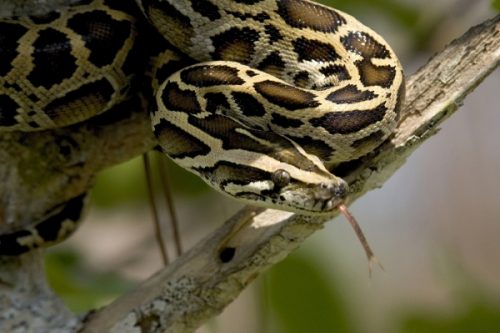The Burmese python (Python bivittatus) is the third largest snake in the world. It is thought to occur in South and Southeast Asia. Burmese pythons are considered semi-aquatic animals because they make habitats near water. They grow to a length of about 1.8 meters (6 feet). Pythons are arboreal species as they spend much of their time into the trees.
Burmese Python Facts
Anatomy
- Adult pythons are mainly recognized by their dark colored body which is dominated by the brownish patterns.
- The patterns of Burmese pythons are slightly different from that of African rock python.
- Females are not only longer but heavier as compared to males.
- Female pythons reach length of about 3.47 m (11 ft 5 in) and weighs 29 kg (64 lb). These are the measurements of captive pythons. The average length of wild pythons is about 3.7 m (12 ft 2 in).
- In captivity adult males can be 2.97 m (9 ft 9 in) long weighs up to 14.5 kg (32 lb). The maximum length of a python ever recorded at 5.74 m (18 ft 10 in).
- Burmese pythons have got long prehensile tail.

Range & Habitat
- Burmese pythons are likely to occupy many countries of Southeast Asia including Bangladesh, Cambodia, western Bhutan, Myanmar, India, northern Malaysia, Nepal, Thailand, Laos, Vietnam, Hong Kong, Indonesia, Bali, and southern China. Pythons have also been introduced in South Florida
- They are absent from the island of Taiwan. The Burmese python is a remarkable swimmer which is they it never goes far away from the water bodies.
- Burmese pythons will make homes in a wide variety of habitats such as grasslands, rocky foothills, open clearings, swamps, woodlands, river valleys, and marshes.
Behavior
- Burmese pythons are nocturnal animals as they emerge in the rainforest at night.
- Young pythons are likely to spend more time on the ground than adults. As they grow older they become arboreal in nature.
- They are thought to be excellent swimmers. Pythons remain submerged in water for as long as 30 minutes.
- Pythons typically hide in the underbrush in the daylight hours. During winter the northern population rests in a hollow tree or under rocks. It is a sort of hibernation.

Feeding Ecology & Diet
- Burmese pythons are carnivores and their diet mainly consists of small birds and mammals. Like pythons, they have got a way to wrap around the prey’s body while seizing it with the sharp teeth.
- Prominent among the python’s prey is rats or mice. They rarely attack deer or alligators.
Reproductive Biology
- The breeding season occurs in the early spring.
- A female lays a clutch size of about 12 – 36 eggs. The egg laying takes place in March or April.
- The female guards the eggs until they hatch. Eggs are never left unattended.
- Burmese pythons have an average lifespan of about 10 – 20 years in captivity.
Conservation Status
Vulnerable


Leave a Reply